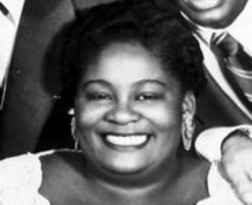Related Research Articles

Johnny Otis was a first generation Greek-American singer, musician, composer, bandleader, record producer, and talent scout. He was a seminal influence on American R&B and rock and roll. He discovered numerous artists early in their careers who went on to become highly successful in their own right, including Little Esther Phillips, Etta James, Alan O'Day, Big Mama Thornton, Johnny Ace, Jackie Wilson, Little Willie John, Hank Ballard, and The Robins, among many others. Otis has been called the "Godfather of Rhythm and Blues".

Willie Mae "Big Mama" Thornton, was an American singer and songwriter of blues and R&B.

Otis Spann was an American blues musician, whom many consider to be the leading postwar Chicago blues pianist.

Johnny Shuggie Otis is an American singer-songwriter, recording artist, and multi-instrumentalist.
Wayne Talmadge Bennett was an American blues guitarist, best remembered for his performances and recordings with Bobby Bland between the 1950s and 1980s.

"Hound Dog" is a twelve-bar blues song written by Jerry Leiber and Mike Stoller. Recorded originally by Big Mama Thornton on August 13, 1952, in Los Angeles and released by Peacock Records in late February 1953, "Hound Dog" was Thornton's only hit record, selling over 500,000 copies, spending 14 weeks in the R&B charts, including seven weeks at number one. Thornton's recording of "Hound Dog" is listed as one of the Rock and Roll Hall of Fame's "500 Songs That Shaped Rock and Roll", ranked at 318 in the 2021 iteration of Rolling Stone's 500 Greatest Songs of All Time and was inducted into the Grammy Hall of Fame in February 2013.
Don and Dewey were an American rock, blues, and R&B duo, comprising Don "Sugarcane" Harris and Dewey Terry.

Joseph Benjamin Hutto was an American blues musician. Influenced by Elmore James, Hutto became known for his slide guitar playing and declamatory style of singing. He was inducted into the Blues Hall of Fame two years after his death.
Lloyd Colquitt Glenn was an American R&B pianist, bandleader and arranger, who was a pioneer of the "West Coast" blues style.
John Leroy "Johnny" Heartsman was an American electric blues and soul blues musician and songwriter. He showed musical diversity, playing a number of musical instruments, including the electronic organ and flute. He contributed his distinctive guitar playing to a number of recordings made in the San Francisco Bay Area in the 1950s and 1960s. He continued playing until his death.
Sidney Maiden was an American country blues musician. Maiden principally played harmonica accompaniment, but also sang on some of his own recordings, in addition to writing several compositions. His best known work is "Eclipse of the Sun" (1948).
Ernest J. McLean was an American rhythm and blues and jazz guitarist.

Marie Adams was an American gospel and R&B singer, who became popular in the 1950s particularly for her work with Johnny Otis.
Charles Eldridge Norris was an American jazz and blues guitarist.
Robert Kelton Jr. was an American blues guitarist and banjo player, influential in the development of jump blues and early rock and roll.
James A. Wynn Jr., known as Big Jim Wynn, was an American jump blues saxophonist, pianist and bandleader.
Willie E. Jackson Jr., known as Little Willie Jackson, was an American jazz and rhythm and blues saxophonist, bandleader and occasional vocalist.
Raymond Clinton "Ray" Agee was an American blues and R&B singer and songwriter who recorded over a hundred tracks between the early 1950s and mid-1970s, and is described at AllMusic as "a fine, versatile blues singer whose work deserves a wider audience".
References
- 1 2 3 Eagle, Bob; LeBlanc, Eric S. (2013). Blues - A Regional Experience. Santa Barbara: Praeger Publishers. p. 340. ISBN 978-0313344237.
- 1 2 3 "Take No Prisoners: The Monster Guitar of Pete Lewis, 1947-1960", Blues Unlimited #221. Retrieved 14 November 2016
- ↑ Larry Birnbaum, Before Elvis: The Prehistory of Rock 'n' Roll, Rowman & Littlefield, 2013, pp.275-276
- ↑ Edward Komara, "Pete 'Guitar' Lewis", The Blues Encyclopedia, Routledge, 2004, p.601
- 1 2 "Pete 'Guitar' Lewis", TheHoundBlog, July 2, 2009. Retrieved 14 November 2016